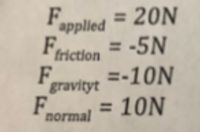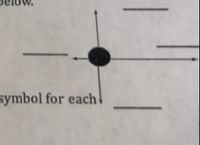
College Physics
11th Edition
ISBN: 9781305952300
Author: Raymond A. Serway, Chris Vuille
Publisher: Cengage Learning
expand_more
expand_more
format_list_bulleted
Concept explainers
Question
Four forces act on a 10-kg mass in the force diagram below:
a) Label the force diagram to the right with the correct symbol for each force arrow or vector.
b) What is the acceleration of this 10-kg mass above? Show equation, plug in number with units, circle answer with correct units.

Transcribed Image Text:**Transcription:**
- \( F_{\text{applied}} = 20 \, \text{N} \)
- \( F_{\text{friction}} = -5 \, \text{N} \)
- \( F_{\text{gravity}} = -10 \, \text{N} \)
- \( F_{\text{normal}} = 10 \, \text{N} \)
**Explanation:**
This text lists different types of forces acting on an object. Each force is described with a label and a magnitude in newtons (N):
1. **Applied Force (\( F_{\text{applied}} \))**: This is the force exerted on an object by a person or another object, measured as 20 newtons.
2. **Frictional Force (\( F_{\text{friction}} \))**: This is the opposing force that acts against the motion, measured as -5 newtons. The negative sign indicates the force is acting in the opposite direction to the applied force.
3. **Gravitational Force (\( F_{\text{gravity}} \))**: This is the force exerted by gravity on the object, measured as -10 newtons. The negative sign suggests the direction of the force is downward.
4. **Normal Force (\( F_{\text{normal}} \))**: This is the support force exerted upon an object that is in contact with another stable object, measured as 10 newtons. It acts perpendicular to the surface.
No graphs or diagrams are present in this image.

Transcribed Image Text:The image shows a dot in the center, with arrows pointing outward in four directions: up, down, left, and right. Each arrow is accompanied by a blank line, suggesting a place for labeling or identifying the directions or associated concepts. The text visible in the image includes the phrase "symbol for each." This might indicate a diagram for understanding directions, forces, or other vector-related concepts in an educational context.
Expert Solution
This question has been solved!
Explore an expertly crafted, step-by-step solution for a thorough understanding of key concepts.
This is a popular solution
Trending nowThis is a popular solution!
Step by stepSolved in 2 steps with 2 images

Knowledge Booster
Learn more about
Need a deep-dive on the concept behind this application? Look no further. Learn more about this topic, physics and related others by exploring similar questions and additional content below.Similar questions
- Match each graph with the correct interpretation of the area beneath the graph.force vs position is momentum, displacement, acceleration, impulse, work, or mass? force vs time is momentum, displacement, acceleration, impulse, work, or mass? velocity vs time is momentum, displacement, acceleration, impulse, work, or mass?arrow_forwardHow would I derive this equation from Newton’s second law?arrow_forwardHelparrow_forward
- The data below is from a student who walked slowly up the stairs, walked quickly up the stairs, and ran up the stairs. Table 1 Mass of Student 55 kg Height of Stairs 2.8 m Force due to Gravity Calculations 1 Calculate the force due to gravity acting on the student. (Reminder: F = m*a; acceleration due to gravity = 9.8 m/s/s). Show your work below and record the value you get in Data Table 1.arrow_forwardA 0.10-kg ball is placed in a shallow wedge with an opening angle of 150°, as shown in(Figure 1). Figure Contact force 1 mg Contact force 2 1 of 1 ▼ For each contact point between the wedge and the ball, determine the force exerted on the ball. Assume the system is frictionless. Determine the Contact force 1. Express your answer using two significant figures. View Available Hint(s) N₁ = Submit Part B Determine the Contact force 2. Express your answer using two significant figures. ► View Available Hint(s) N₂ = G| ΑΣΦ Submit [5] ΑΣΦ Provide Feedback ? ? N N Review O Next >arrow_forwardConsider the diagram below of a box with a mass 4.45 kg sliding down a ramp. The ramp is inclined at 0=60.0° above the horizontal. If the block slides with at a constant velocity what is the force of friction acting on the mass? Give your answer in Newton's to 1 decimal place but do NOT include units in your answer. 0 marrow_forward
arrow_back_ios
arrow_forward_ios
Recommended textbooks for you
 College PhysicsPhysicsISBN:9781305952300Author:Raymond A. Serway, Chris VuillePublisher:Cengage Learning
College PhysicsPhysicsISBN:9781305952300Author:Raymond A. Serway, Chris VuillePublisher:Cengage Learning University Physics (14th Edition)PhysicsISBN:9780133969290Author:Hugh D. Young, Roger A. FreedmanPublisher:PEARSON
University Physics (14th Edition)PhysicsISBN:9780133969290Author:Hugh D. Young, Roger A. FreedmanPublisher:PEARSON Introduction To Quantum MechanicsPhysicsISBN:9781107189638Author:Griffiths, David J., Schroeter, Darrell F.Publisher:Cambridge University Press
Introduction To Quantum MechanicsPhysicsISBN:9781107189638Author:Griffiths, David J., Schroeter, Darrell F.Publisher:Cambridge University Press Physics for Scientists and EngineersPhysicsISBN:9781337553278Author:Raymond A. Serway, John W. JewettPublisher:Cengage Learning
Physics for Scientists and EngineersPhysicsISBN:9781337553278Author:Raymond A. Serway, John W. JewettPublisher:Cengage Learning Lecture- Tutorials for Introductory AstronomyPhysicsISBN:9780321820464Author:Edward E. Prather, Tim P. Slater, Jeff P. Adams, Gina BrissendenPublisher:Addison-Wesley
Lecture- Tutorials for Introductory AstronomyPhysicsISBN:9780321820464Author:Edward E. Prather, Tim P. Slater, Jeff P. Adams, Gina BrissendenPublisher:Addison-Wesley College Physics: A Strategic Approach (4th Editio...PhysicsISBN:9780134609034Author:Randall D. Knight (Professor Emeritus), Brian Jones, Stuart FieldPublisher:PEARSON
College Physics: A Strategic Approach (4th Editio...PhysicsISBN:9780134609034Author:Randall D. Knight (Professor Emeritus), Brian Jones, Stuart FieldPublisher:PEARSON

College Physics
Physics
ISBN:9781305952300
Author:Raymond A. Serway, Chris Vuille
Publisher:Cengage Learning

University Physics (14th Edition)
Physics
ISBN:9780133969290
Author:Hugh D. Young, Roger A. Freedman
Publisher:PEARSON

Introduction To Quantum Mechanics
Physics
ISBN:9781107189638
Author:Griffiths, David J., Schroeter, Darrell F.
Publisher:Cambridge University Press

Physics for Scientists and Engineers
Physics
ISBN:9781337553278
Author:Raymond A. Serway, John W. Jewett
Publisher:Cengage Learning

Lecture- Tutorials for Introductory Astronomy
Physics
ISBN:9780321820464
Author:Edward E. Prather, Tim P. Slater, Jeff P. Adams, Gina Brissenden
Publisher:Addison-Wesley

College Physics: A Strategic Approach (4th Editio...
Physics
ISBN:9780134609034
Author:Randall D. Knight (Professor Emeritus), Brian Jones, Stuart Field
Publisher:PEARSON